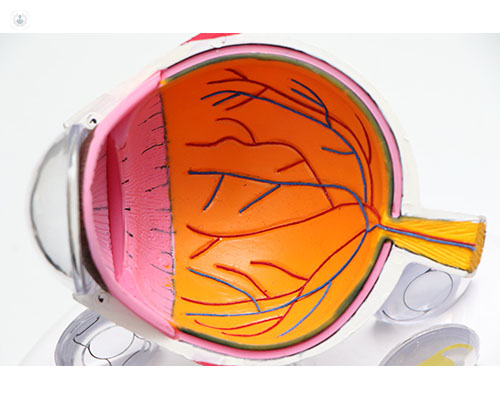Age-related macular degeneration: your questions answered
Escrito por:In her latest online article, leading consultant vitreoretinal surgeon Ms Evgenia Anikina offers her expert insight into age-related macular degeneration (AMD). She explains the difference between dry and wet AMD, which is typically considered more severe, and the treatment for both.

What is dry age-related macular degeneration?
Dry age-related macular degeneration is a degenerative condition which develops in the central retina with advancing age. It is almost inevitable that most people develop it eventually if they are fortunate enough to live a long life.
How quickly it develops and its’ severity is governed by many things, such as genetic factors, lifetime sun exposure, diet and smoking. What happens in dry AMD is that the light-sensing cells (the photoreceptors) in the outer layers of the retina gradually begin to die away. The vision can become dimmer, less focused and occasionally distorted. These changes are often mild and very slowly progressive.
What is the difference between dry and wet age-related macular degeneration?
In dry AMD, the retinal cells are gradually lost due to a degenerative process. The condition often produces relatively mild visual impairment and tends to progress slowly. There is currently no effective treatment for dry AMD, although several research avenues are looking promising for the near future. A number of strategies exist that focus on prevention, slowing down progression and reducing the chance of dry AMD transforming to the wet type.
These include smoking cessation, dietary changes and vitamin supplementation. Wet AMD is an entirely different condition, where abnormal blood vessels develop underneath the central retina, in the deeper layers of the eye wall. These vessels can leak fluid and sometimes cause bleeding, changes which usually result in quite rapid loss of vision, which can be quite profound. Once diagnosed, wet AMD can often be treated with special injections, which need to be performed at intervals of a few weeks, which help to reverse some of the sight loss and slow down the progression of the condition.

Is one more severe than the other?
Dry AMD is often thought to be less severe than wet AMD and it is certainly much more common. Many people are living with dry AMD without being aware of it because the visual effects can be mild. This is not always the case, however, occasionally dry AMD can also take away significant amounts of vision over time. It is also true that one condition can transform to the other. It should also be borne in mind that there is an effective treatment available for wet AMD, which can often reverse and stabilise the rapid visual loss in this condition, whereas dry AMD can be thought of as “wear and tear” of the retina and at present cannot be effectively reversed.
How does treatment for both compare or differ?
The strategies for managing dry AMD centre around prevention and visual maximisation. This involves things like specialist low vision clinics to explore visual aids, optimising the glasses prescription, and helping select magnifiers. Lifestyle advice once diagnosed with the condition centres around slowing down progression and involves things like smoking cessation, eating a healthy diet and vitamin supplementation.
Some surgical techniques include implantable magnifying lenses/telescopes, however, these are suitable for a small minority of patients only and at present have not been very widely used or tested. Wet AMD, once diagnosed, will usually require an urgent intra-ocular injection of a class of drug called an anti-VEGF agent, of which several exist on the market. Common names include Lucentis (Ranibizumab) and Eylea (Aflibercept). Other agents are coming onto the market all the time. You would typically be offered the drug which you doctor thinks would work best in your case and you would often need to have a course of injections, with a treatment every few weeks for a few months before the condition is stabilised.
What is the prognosis of both?
Dry AMD often produces a mild visual impairment which progresses slowly. Sometimes, enough vision is lost over time to mean that you no longer fulfil the DVLA criteria for driving and struggle to read, however, this typically takes many years to develop. A genetic predisposition as well as an unhealthy lifestyle can accelerate these changes. With wet AMD, a lot of the visual impairment at the time of first diagnosis can be reversed, however, it is true to say that treatment slows down the progression rather than stops it completely. This slowing effect can be enough for a lot of people to mean that vision remains good after treatment for many years.

In some rare cases, the treatment is unable to stop the changes that are happening and vision can remain poor. Both conditions affect both eyes, however, they can be asymmetrical and often if the vision is poor in one eye, the other eye will still function. It is also true that you never lose vision completely or go blind from either one of these conditions, as they do not generally involve the whole retina, but are confined to the central part of the retina, called the macula. This means that the sharp “reading vision” is impaired, however, the peripheral “navigational vision” is preserved.
Ms Evgenia Anikina is a renowned consultant vitreoretinal surgeon based in London. If you would like to book a consultation with Ms Anikina, you can do so today via her Top Doctors profile.


